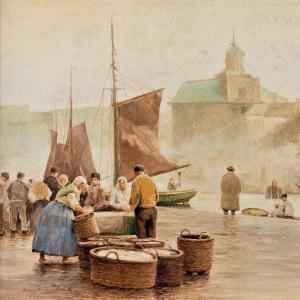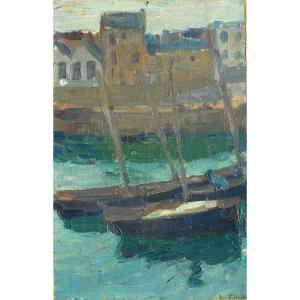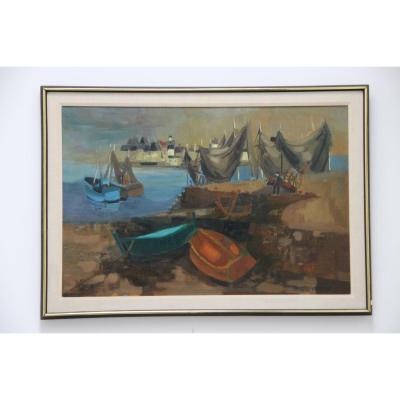This luminous coastal landscape, depicting the Calanche rock formations of Corsica, reveals a lesser-known but deeply resonant dimension of Paul Justin Marcel Balmigère’s artistic identity. Best known for his refined academic portraits and symbolist-inflected figural works, this canvas shows Balmigère engaging directly with the southern landscape, in a mode that is both painterly and meditative.
The scene unfolds in soft but vibrant colors: vermillion cliffs plunge into crystalline waters, their rugged forms mirrored in the calm, green-blue sea. The light is golden yet diffused, possibly early morning or late afternoon, suggesting a temporal stillness that enhances the sense of solitude and elemental grandeur. The massif of the Corsican coast rises in the distance, rendered with gentle tonal transitions and atmospheric depth—a testament to the artist’s sensitivity to both form and light.
What is striking here is Balmigère’s balance between naturalistic observation and emotional lyricism. This is not an anonymous Mediterranean landscape, but a place deeply felt: the composition is structured, yet the brushwork is loose and expressive, especially in the treatment of water and rock textures. His signature in the lower left corner, “P. Balmigère”, anchors the work in authorship without disrupting the image’s quietude.
This painting belongs to a landscape tradition rooted in 19th-century realism, but filtered through the post-impressionist ethos of light and color. One might see echoes of Jean-Baptiste-Camille Corot, or of Henri Martin’s luminous southern scenes, yet Balmigère’s work remains free of decorative stylization. There is no theatrical effect here, no overstated colorism—only a studied, introspective homage to nature, echoing the artist’s broader practice of restraint and inwardness.
In terms of his overall oeuvre, coastal view Calanche in Corsica occupies a parallel path to his symbolist and academic figural works. It may reflect personal travels or a retreat from the urban environment, allowing the painter to engage with landscape as a site of both visual contemplation and spiritual resonance. The coastal subject also links Balmigère back to his Occitan and Mediterranean heritage, subtly affirming his deep affinity with the light, forms, and silences of the South.
This canvas, painted with technical assurance and emotional tact, offers a glimpse into Balmigère’s capacity to observe the world not just as a classical draftsman, but as a quiet poet of the visible.










































 Le Magazine de PROANTIC
Le Magazine de PROANTIC TRÉSORS Magazine
TRÉSORS Magazine Rivista Artiquariato
Rivista Artiquariato